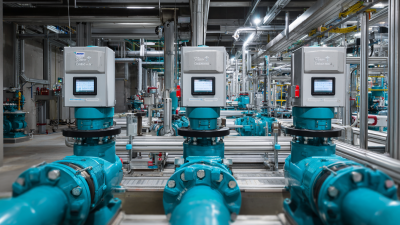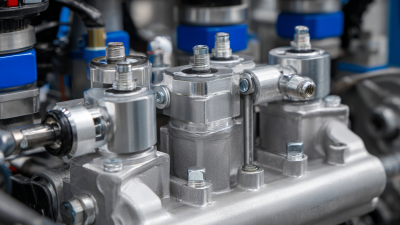What is the Future of Automated Valves in Modern Industries
As industries continue to evolve with rapid technological advancements, the importance of automation has never been more pronounced. Among the key components driving this change are automated valves, which are revolutionizing the way fluids and gases are controlled in various applications. These sophisticated devices not only enhance efficiency but also improve safety and reduce operational costs across sectors like manufacturing, oil and gas, and wastewater management. In this blog, we will explore the future of automated valves in modern industries, examining emerging trends, innovative technologies, and best practices for implementation. By understanding how to leverage these advancements, industries can optimize their processes, achieve sustainability goals, and ultimately position themselves for success in an increasingly competitive landscape. Join us as we delve into the transformative potential of automated valves and how they are set to shape the future of industrial operations.

The Role of Automated Valves in Enhancing Industrial Efficiency
Automated valves are becoming crucial in modern industries, with their role in enhancing operational efficiency gaining significant recognition. According to a report by MarketsandMarkets, the global market for automated valves is projected to reach $13.07 billion by 2026, growing at a compound annual growth rate (CAGR) of 6.5% from 2021. This growth stems from the increasing demand for process automation across various sectors, including oil and gas, water and wastewater management, and chemical manufacturing. By automating valve operations, industries can optimize their processes, reduce human error, and improve safety measures, which collectively lead to enhanced productivity.

Additionally, research from Mordor Intelligence indicates that industries incorporating automated valves can reduce operational costs by as much as 20% through improved energy management and waste reduction. Automated valves allow for real-time monitoring and control of fluid flow, which not only enhances precision but also simplifies maintenance routines. As industries strive for sustainability and cost-effectiveness, the shift toward automation—facilitated by advanced technologies like IoT and AI—will continue to transform operational landscapes, positioning automated valves as vital components in achieving higher industrial efficiency.
Innovative Technologies Transforming Automated Valve Systems
The landscape of automated valve systems is rapidly evolving, driven by innovative technologies that enhance efficiency and reliability across various industries. According to a recent report by MarketsandMarkets, the automated valves market is projected to reach $9.6 billion by 2026, growing at a compound annual growth rate (CAGR) of 6.2% from 2021. This growth is primarily fueled by increasing demands for automation in sectors like oil and gas, water and wastewater management, and pharmaceuticals. Advanced valve technologies, including smart sensors and IoT integration, are revolutionizing the way valves operate, leading to improved performance and maintenance capabilities.
One notable trend in the industry is the adoption of Artificial Intelligence (AI) and machine learning algorithms in automated valve systems. These technologies are enabling predictive maintenance, which can significantly reduce downtime and operational costs. According to a study by Frost & Sullivan, companies that implement AI-driven predictive maintenance strategies can reduce maintenance costs by up to 30%. Additionally, the integration of Industry 4.0 principles is facilitating real-time data analytics, allowing for instantaneous adjustments to valve operations based on dynamic process parameters. This shift not only enhances system efficiency but also contributes to overall sustainability efforts within modern industrial environments.
Key Industries Benefiting from Automated Valve Integration
 Automated valves are poised to revolutionize various key industries, making processes more efficient and reliable. In the chemical and petrochemical sectors, these valves enhance safety and precision control during hazardous material handling. By automating the flow of corrosive or flammable substances, companies mitigate risks associated with manual operations, significantly reducing the likelihood of leaks or spills which could lead to catastrophic consequences.
Automated valves are poised to revolutionize various key industries, making processes more efficient and reliable. In the chemical and petrochemical sectors, these valves enhance safety and precision control during hazardous material handling. By automating the flow of corrosive or flammable substances, companies mitigate risks associated with manual operations, significantly reducing the likelihood of leaks or spills which could lead to catastrophic consequences.
In the water treatment and management industry, automated valves are crucial for optimizing resource use and protecting environmental sustainability. These valves allow for real-time monitoring and regulation of water flow, ensuring that systems operate at peak efficiency. By integrating automated solutions, utilities can improve response times during emergencies and streamline operations, ultimately leading to cost savings and better service delivery.
Moreover, the food and beverage sector is also harnessing the benefits of automated valves to meet stringent hygiene standards and enhance productivity. By automating processes such as ingredient mixing and bottling, companies can ensure consistency and quality while reducing the risk of contamination. As industries continue to embrace technological advancements, the integration of automated valves will play a critical role in driving innovation and operational excellence.
Challenges and Solutions in the Adoption of Automated Valves
In the rapidly evolving landscape of modern industries, the adoption of automated valves is gaining momentum. However, businesses face several challenges that hinder seamless integration. One of the primary obstacles is the high initial investment cost associated with automated systems. Companies often struggle to justify these expenditures against anticipated long-term savings. Therefore, conducting thorough cost-benefit analyses can be a game changer for organizations looking to invest in automation.
Another challenge lies in the need for skilled personnel to operate and maintain automated valves effectively. There is a significant skills gap in many industries, which can lead to inefficient use of these technologies. To mitigate this, companies should invest in comprehensive training programs for their workforce. Regular workshops focusing on the latest automation technologies can empower employees and enhance operational efficiency.
Tip: To ensure a smoother transition to automated valve systems, consider starting with pilot projects that allow companies to evaluate performance and adjust operational strategies accordingly. Additionally, collaborating with experienced vendors can provide insights and recommendations that drive successful adoption and maximize return on investment.
What is the Future of Automated Valves in Modern Industries - Challenges and Solutions in the Adoption of Automated Valves
| Dimension | Current Challenges | Proposed Solutions | Future Trends |
|---|---|---|---|
| Cost Efficiency | High initial investment | Leverage financing options | Decrease in overall maintenance costs |
| Integration | Compatibility with legacy systems | Develop flexible interfaces | Seamless connectivity for IoT |
| Reliability | Failure rates in critical applications | Implement predictive maintenance | Increased robustness with smart technology |
| User Training | Lack of skilled personnel | Enhanced training programs | Focus on user-friendly interfaces |
| Regulatory Compliance | Meeting safety standards | Consult with regulatory experts | Stricter compliance reports via automation |
Future Trends in Automated Valve Design and Functionality
In recent years, automated valves have become an essential component in various modern industries, revolutionizing the way systems manage fluid control. The future trends in automated valve design indicate a significant shift towards smart technology integration. According to a report by MarketsandMarkets, the global smart valve market is projected to reach USD 5.61 billion by 2025, growing at a compound annual growth rate (CAGR) of 7.5%. Such advancements aim to improve efficiency and minimize downtime, as industries increasingly seek reliable and precise control over their processes.
Another prominent trend is the increasing adoption of Internet of Things (IoT) technologies. Automated valves equipped with IoT capabilities enable real-time monitoring and predictive maintenance, reducing the risk of failures and enhancing operational efficiency. A study by ResearchAndMarkets highlights that the IoT in the industrial sector is expected to grow to USD 110.61 billion by 2025, underscoring the demand for smarter and more connected automated solutions. As industries evolve towards sustainable practices, the integration of energy-efficient designs in automated valves will also play a critical role in minimizing environmental impact while maximizing performance.
Related Posts
-

Exploring Innovative Alternatives in Control Valves: A Global Purchasing Perspective
-

7 Essential Tips for Choosing Hydraulic Flow Control Valves for Your Business
-

How to Optimize Your System with Automated Valves for Maximum Efficiency
-

Addressing Common Hydraulic Flow Control Challenges: Insights and Data from Industry Experts
-

Essential Checklist for Selecting the Right Proportional Valves for Your Applications
-

5 Best Fluid Power Hydraulics Solutions for Optimal Performance
 skip to Main Content
skip to Main Content
